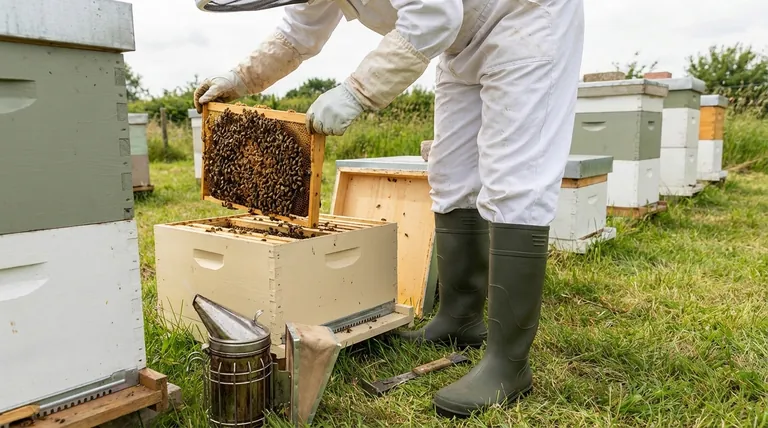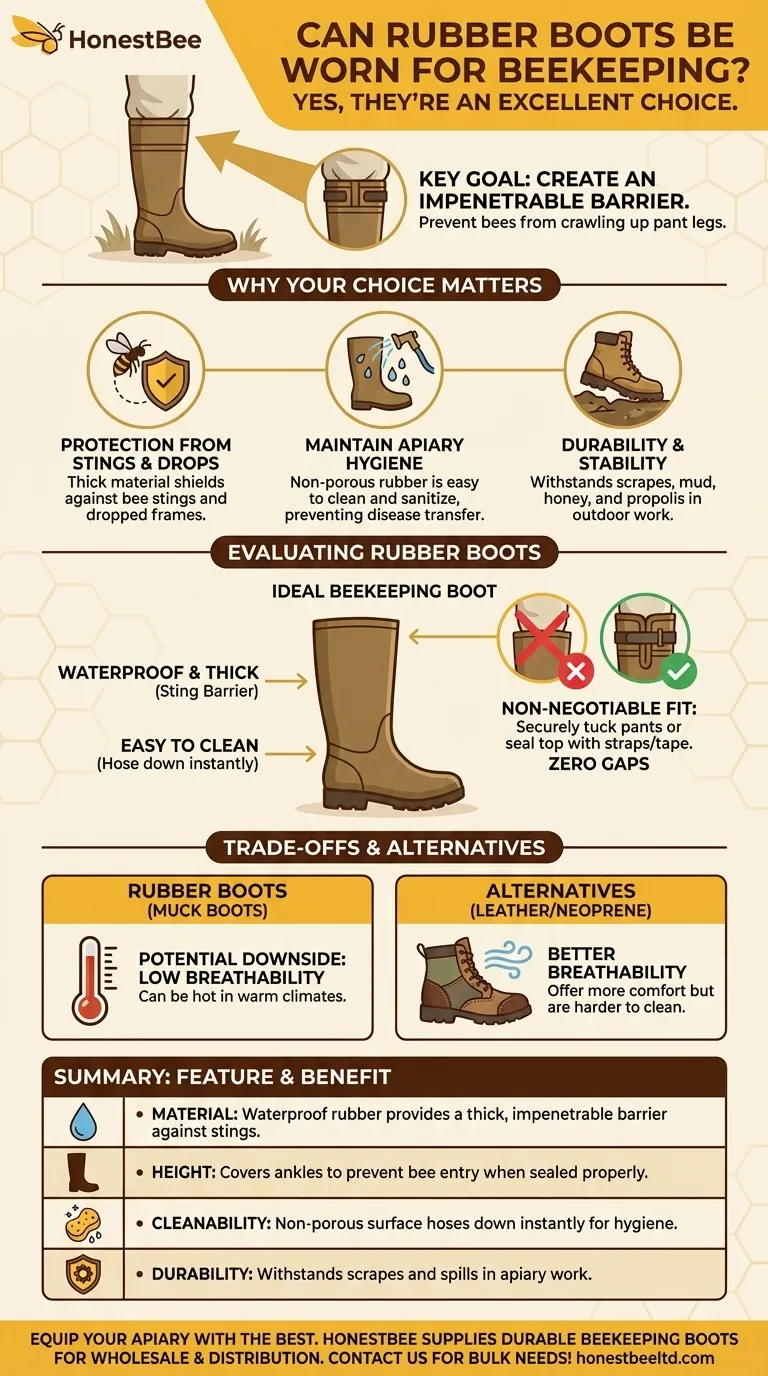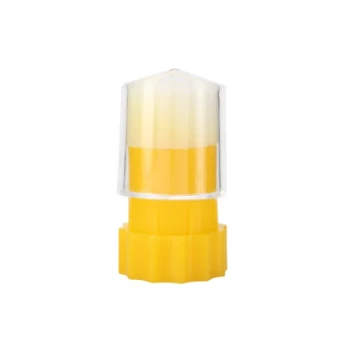Yes, rubber boots are an excellent choice for beekeeping. They provide crucial protection for your feet and ankles, are exceptionally easy to clean, and create a solid barrier that prevents bees from crawling up your pant legs. The most important consideration is ensuring there is no gap at the top where a bee could enter.
The most effective beekeeping footwear is not about a specific brand, but about the principle of creating a seamless, impenetrable seal from your foot to your pant leg. Rubber boots are a popular and effective tool for achieving this, offering a practical balance of protection, hygiene, and affordability.

Why Your Choice of Footwear Matters in Beekeeping
Choosing what to wear on your feet in an apiary is a critical safety decision. The right boots protect you from more than just stings; they provide stability and peace of mind.
The Primary Goal: An Impenetrable Barrier
The greatest risk is not a bee stinging your shoe, but one crawling inside your clothing. A bee trapped inside your pant leg is a guaranteed sting in a highly undesirable location.
Proper boots should be tall enough to cover your ankles, allowing you to either tuck your pants into them or securely fasten your pant legs over them.
Protection from Drops and Spills
Accidents happen, and a beekeeper might occasionally drop a frame covered in bees. Sturdy, thick material like rubber shields your feet and ankles from the resulting chaos.
This is why open-toed shoes, sandals, or even low-cut sneakers are considered dangerously inadequate for beekeeping.
Maintaining Apiary Hygiene
Apiaries can be wet, muddy, and sticky with honey, wax, and propolis. Rubber boots are non-porous and can be hosed down and sanitized in seconds.
This ease of cleaning is not just for convenience; it helps prevent the potential transfer of bee diseases between different apiary locations.
Evaluating Rubber Boots as a Beekeeping Option
While many types of boots can work, rubber boots (often sold as "muck boots" or agricultural boots) have a unique set of features that make them ideal for the job.
Key Strength: Protection and Durability
Rubber is naturally waterproof and thick enough to prevent bee stingers from penetrating. It holds up well against the scrapes and scuffs common in outdoor work.
Key Strength: Ease of Cleaning
As mentioned, nothing is easier to clean than a simple rubber boot. This helps you keep your equipment in good condition and maintains a clean working environment.
The Non-Negotiable Fit: Securing the Top
A loose, wide-mouthed boot is a significant vulnerability. Your bee suit or pants must be securely tucked into the boot or fastened tightly over the outside with straps, ties, or even duct tape. Your goal is to leave zero gaps.
Understanding the Trade-offs
While excellent, rubber boots are not without potential downsides. Understanding these trade-offs helps you make a fully informed decision.
The Main Downside: Breathability
Solid rubber is not a breathable material. In hot and humid climates, your feet can become very warm and sweaty during long hive inspections.
Common Alternatives: Leather and Neoprene
Some beekeepers prefer tall leather work boots, which offer good protection and better breathability than rubber. However, they are harder to clean and can absorb moisture.
Boots that combine a rubber foot with a more flexible neoprene upper (like many Muck Boot models) offer a good compromise between waterproof protection and comfort.
Specialized "Beekeeper Boots"
You may see white boots marketed specifically for beekeepers. These are typically just white rubber boots. The color makes it easy to spot bees and dirt, but they function identically to any other rubber boot.
Making the Right Choice for Your Apiary
Ultimately, your choice should be guided by your specific needs, climate, and budget. Use your gear to build confidence, not create doubt.
- If your primary focus is maximum protection and hygiene: A pair of seamless, tall rubber boots (like agricultural or muck boots) is the definitive choice.
- If your primary focus is comfort in a hot climate: Consider boots with a breathable neoprene upper or a pair of tall leather work boots, ensuring you have a reliable method for sealing your pant legs.
- If you are working with a limited budget: A simple pair of hardware store rain boots will provide adequate protection, as long as you are diligent about sealing the tops to prevent bee entry.
Choosing footwear that makes you feel secure allows you to focus on what matters most: the health and productivity of your bees.
Summary Table:
| Feature | Benefit for Beekeepers |
|---|---|
| Material | Waterproof rubber provides a thick, impenetrable barrier against stings. |
| Height | Covers ankles to prevent bees from crawling up pant legs when sealed properly. |
| Cleanability | Non-porous surface can be hosed down instantly to maintain apiary hygiene. |
| Durability | Withstands scrapes, propolis, and honey spills common in beekeeping work. |
Equip your commercial apiary or distribution business with the best.
HONESTBEE supplies durable, high-quality beekeeping boots and equipment designed for the demands of professional beekeepers and distributors. Our wholesale-focused operations ensure you get the reliable protection you need to work confidently and maintain hive health.
Contact HONESTBEE today to discuss your bulk footwear and equipment needs!
Visual Guide

Related Products
- Cotton Beekeeping Suit and Round Hat with Veil Bee Keeper Protective Gear
- Beekeeper Cowboy Hat and Veil for Beekeeping
- HONESTBEE Professional Telescopic Pole Bee Swarm Catcher
- Premium Traditional Copper Bee Smoker with Bellows
- High Performance Plastic Queen Excluder for Beekeeping and Apiary Management
People Also Ask
- What are the benefits of a fully ventilated beekeeping suit? Stay Cool and Protected in Hot Climates
- Why is a jacket with a hat veil recommended for beekeepers? Essential Protection for Your Face and Neck
- What factors should be considered when choosing a beekeeping suit? Balance Safety, Comfort & Performance
- What should be considered regarding the color of beekeeping clothing? Ensure Your Safety and Keep Bees Calm
- How should a bee suit be cleaned? Protect Your Investment and Ensure Apiary Safety



















